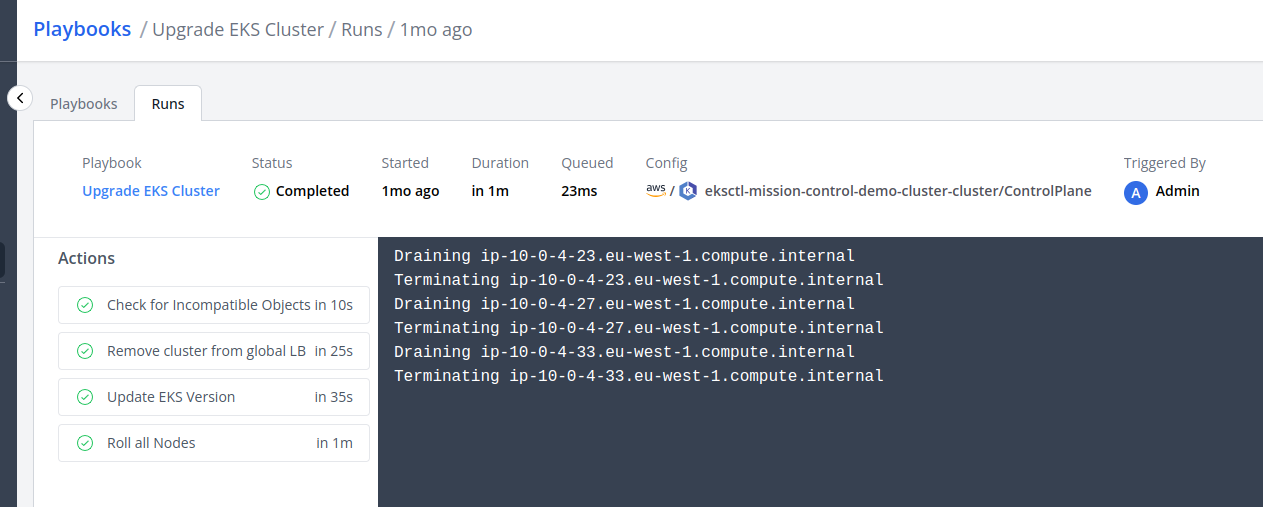Playbooks
Playbooks automate common workflows and processes by defining reusable templates of actions that can be triggered on-demand by users, when specific events happen or through webhooks.

Some key benefits include:
- Accelerated GitOps Adoption - Use "ClickOps" to make changes to resources but have them being applied as Git pull requests in the background, enabling non-technical teams to leverage GitOps workflows.
- Consistency - Provide easy to discover and reusable templates for common tasks, preventing the complexity of doing the same thing multiple ways.
- Self-Service - Enable developers/operators to provision and manage their own resources without involving a central DevOps/Platform team.
- Compliance - Improve compliance and security by limiting the need for elevated privileges.
- Cost Efficiency - Optimize costs with on-demand environments that spin down after a fixed duration.
- Portability - A consistent interface for performing operations irrespective of the underlying infrastructure and/or environment
Use cases
Provisioning
Day 2 Operations
Day 2 operations can be added onto existing resources (configs, components or health checks) using resource selectors.
For example scaling a Kubernetes Deployment is only applicable to config items of type: Kubernetes::Deployment
scale-deployment.yamlapiVersion: mission-control.flanksource.com/v1
kind: Playbook
metadata:
name: scale-deployment
spec:
description: Scale Deployment
configs:
- types:
- Kubernetes::Deployment
parameters:
- name: replicas
label: The new desired number of replicas.
actions:
- name: kubectl scale
exec:
script: |
kubectl scale --replicas={{.params.replicas}} \
--namespace={{.config.tags.namespace}} \
deployment {{.config.name}}
Before running a playbook, users can provide input using parameters.
In the playbook above, the user can decide the new number of replicas before running the playbook.
Just In Time Access
AIOps
Actions
Playbooks execute a sequence of actions (steps), these actions can update git repositories, invoke pipelines or run command line tools like kubectl and aws.
Templating
The actions values can be templated using Go Templates
restart-deployment.yaml#...
kind: Playbook
spec:
configs:
- types:
- Kubernetes::Deployment
actions:
- name: 'Restart kubernetes deployment'
exec:
script: kubectl rollout restart deployment {{.config.name}} -n {{.config.tags.namespace}}
The parameters to the playbooks are available in the Context

Approval
Playbooks can require approval before execution by configuring an approval block:
approve-kubernetes-scaling.yaml#...
kind: Playbook
spec:
#...
approval:
type: any
approvers:
people:
- admin@local
teams:
- DevOps
| Field | Description | Scheme | Required |
|---|---|---|---|
type | How many approvals required. Defaults to all | any or all | false |
approvers.[]people | Login or id of a person | People | false |
approvers.[]teams | Name or id of a team | Team | false |
Permissions
Playbook permissions control who can perform various actions on playbooks.
playbook-permissions.yaml---
# yaml-language-server: $schema=../../config/schemas/permission.schema.json
apiVersion: mission-control.flanksource.com/v1
kind: Permission
metadata:
name: allow-user-playbook-run
spec:
description: |
allow user john to run any playbook but only on configs in `mission-control` namespace
subject:
person: john@doe.com
actions:
- playbook:*
object:
playbooks:
- name: "*" # this is a wildcard selector that matches any playbook
configs:
- namespace: mission-control
Required Permissions
To run a playbook, a principal (user, team, or service account) needs:
- The
playbook:runpermission on the playbook - A
readpermission on the resource the playbook targets
For example, to run a playbook that scales a Kubernetes deployment, the principal needs:
playbook:runpermission on the scaling playbookreadpermission on the target Kubernetes deployment resource
Permission Types
| Permission | Description |
|---|---|
playbook:run | Run a playbook |
playbook:approve | Approve a playbook run |
playbook:cancel | Cancel a running playbook |
Permission Inheritance
When a playbook triggers another playbook, the permissions are evaluated using the playbook's identity, not the original user who initiated the first playbook. This means the triggering playbook must have permission to run the target playbook and to read the resources.